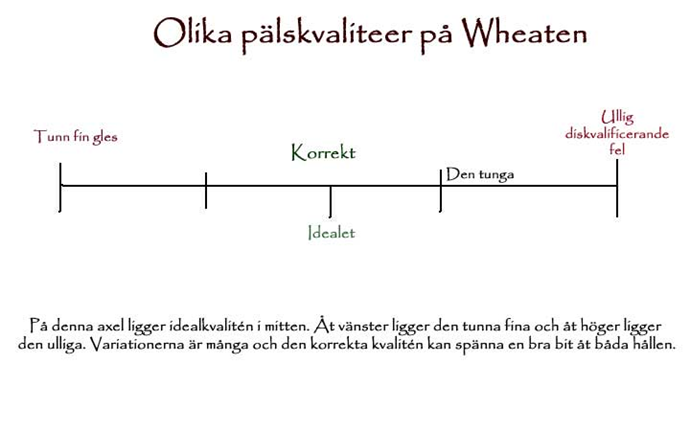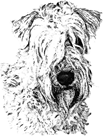|
|
KENNEL VILLAROSA SOFTCOATED WHEATEN TERRIER Last update 2024-12-28
Here are some examples of different coats in 5 days old pups
 Structure
Structure
|
| |
One reason to fall in love with this breed
is the wonderful soft and silky coat.
In the breed are some different coat qualities and since we got our first Wheaten 1985, the discussions about which quality is the correct has been going on.
Since the breed originated from Ireland and in the FCI countries it is the The Kennel Club of the land of origin who decides the standard there shouldn't be any problem, one would think..... Unfortunately it is the interpretation of how the breed standard describes the coat texture would look like and (and – it is there twice) feel to touch that is the reason of many arguments. This has unfortunately not been good for the breed. Here comes some explanations of the most common varieties.
We have been breeding for the silky so called Irish coats since the end of the 1980s and having the experience of seeing more than 50 litters grow up, I have come to the conclusions that there are a lot of different types of the silky coats, inherited in different ways. I will here mention a few but the most common.
Below are some explanations of the most common types.
A CORRECT COAT IS ALWAYS ABUNDANT!
A clean coat of correct quality always feels cool when putting your hands in it!!
THE RED HARSH COATI'll start with the coat I have learned to be the correct, "the red harsh coat”. As newborn and dry, they are red with black strips and mask or no black strips or mask (selfmasked). The coat is not soft and shiny and its often very dense. You can hardly see the skin when moving the coat backwards. When they are 3-4 weeks the coats looks like that on a Border- or an Irish terrier pup depending on if they have black tips or not. Up to when they are about 1 year it grows slowly and they often look like the lighter coloured Irish Terrier, still very red but not copper as most Irish Terriers are today. The coat is not sparse it's very thick and short and the soft coat is slowly growing in. When they are 12-18 months it starts growing rapidly and when they are 2 years the coat is matured and lovely. The hair is soft but quite thick compared to the next quality. It is almost never white during the development and gets a wonderful colour as adult. This coat is very easy to brush and comb and dogs with this coat doesn't mat or tangle very much. It has a natural oil in it as well and doesn't get wet through when out in rain and dries very fast when coming back in, wet on the surface. This was the coat type the Irish farmers loved cause it was easy to handle after a day out in the mud. I think this coat is dominant inherited since you get a lot of different coats breeding this together. We have only one time got a full litter with this coat. This coat grows bigger for every year and are a really beautiful show coat. Wellknown dogs with this coat are Geijes Killmore, Maroc Inishkea and Villa Rosas Queve-Jumper for example. Photos of red/harsh  |
THE FINE SILKY COAT This coat is much finer and mostly much sparser. Newborn dry pups with this coat are often quite dark even black with a light wheatencolour nearest the skin. It is not dense and you can easily see the skin through when moving the coat backwards. It grows very slowly and is sparse until the dog is over 2 years. The hair is very fine and very soft and silky. They are often quite white until the adult coat has grown in. This coat mats and tangle easily with small knots, especially when changing from puppy to adult coat, that can take over a year. The matured coat is beautiful but hasn't the natural oil and gets soaked when raining. I think this is the coat you are talking about when you say the "Irish" coats are sparse". I think this coat is recessive behind the other mentioned. Since if you breed this coat together you never get a red harsh puppy. We normally have one or two pups with this coat in our litters. THE RED7HARCH AND FINE SILKY COATS USE TO BE CALLED SILKY OR "IRISH" Photos Fine coat
THE WOOLLY COAT This coat is thick and woolly and never gets the shine or silky look. It is dry and dull and soaks easily. As puppies they look wonderful, like small bears. It grows very fast and is thick and dense. It has no loose curls or waves and is mostly straight or frizzy. It is also very hard to keep and mats a lot. Many owners with dogs who have this coat shave them or trim them very short to be able to handle the coat. This coat is described in the FCI standard as a disqualifying fault. Sometimes we get one or two woolly pups in our litters, but it is quite rare. It seems that curly (kinky) silky coated dogs gives woolly offspring more often than wavy silky does. This is for sure called "American" here in Sweden, which I think is bad since I've seen so many American dogs with correct silky coats. Wolly coat photos |
THECHINCHILLA COAT These pups are also often red with more or less black tips and black mask. The coat on the dry newborn pup is soft, silky and shining. It grows very fast and is soft and silky all the time. There is no wool in it. In this coat the hair is finer than the first but not as fine as the second. It is not as dense as the first either, but not as sparse as the second. This coat will mostly mature very fast and use to be ready when the dog is 18 months. It tangles a little bit more than the first but is still quite easy to handle. This coat seems to have a little of this natural oil as well and doesn't get so soaked as the second above, when out in the rain. This can be a varant of the "red harsh coat" since when we bred Tic-Tac to Maroc Na Siona, who was red and harsh as pup, we got "red harsh coats" on all pups. Example of the dogs we have bred with this coat are ie. Villa Rosas Paddy and Villa Rosas Tic-Tac. Honeyrags Island Duke to Villa Rosa (Snorre) also has this coat. We use to have one or two in a litter. THIS COAT CAN BE HARD TO PLACE WHEN THEY ARE PUPS IF YOU HAVEN'T HAD A PUP WITH THIS COAT BEFORE, SINCE THEY DON'T ALWAYS LOOK LIKE A TYPICAL SILKY "IRISH" BUT NOT AS A HEAVY "AMERICAN “ EITHER. AS ADULTS IT IS ALWAYS A CORRECT SILKY "IRISH" COAT. Photos of Chinchilla  |
THE HEAVY (MIXED) COAT Sometimes it happens that there are puppies born in the litters with more or less ” big” coat. I used to call the coats that are very much like the Chinchilla coat but, with more or less wool in it, for heavy. It usually takes a long time for the wool to go away, mostly the dog is over 3 years or even more. But this coat is silky and shiny and has more or less of the natural oil in it. It is much harder to take care of this coat than of the first and third above, especially during the time when the wool is growing out and that can go on for years. It is very heavy to comb and brush so that’s why I call it heavy. This coat is very common on dogs in Sweden and when the wool has grown away it is beautiful and shiny but as long as the wool is there it is not correct since the FCI standard says the Wheatens have a single coat and penalise wool, but when the wool is gone it's often correct though many dogs have harder and thicker coat texture. Many dogs from "mixed " lines get this coat. When the dogs are young it's often very woolly and called "American". As adult it depends on how much wool there still are. We have had pure Irsh pups with this coat, that has cleared out the wool before they were one year, but mostly it takes longer time. This coat is also quite often frizzy. Heavy coat photos  |
There is not only the quality , but curls and colour to look for as well.
The breed standard says the coat should be wavy or have loose curls.
The difference can be quite big, but small curls, kinky, as a Lagotto or Poodle is not allowed in a wheaten coat. You can also quite often see, especially in the heavy coats, dogs with a kind of kinky fall even if the coat on the body looks to be wavy. These dogs carry the gene for kinky coat.
I have also seen that dogs with a correct silky coat that carries the kinky gene, or have the kinky coat give more off -spring with the heavy or even woolly coat. A straight coat without waves or curls is not correct either, but it's very rare. Pups and young dogs should always be excluded since the development of the coat can differ very much.
A dog with the correct coat quality can have a kinky coat!
If you look really close into the hair in a heavy or woolly coat, it IS actually frizzy! That is why that coat stands out instead of falling down in waves or loose curls.
THE COLOUR
The breed standard says.
"A good clear wheaten of shades from light wheaten to a golden reddish hue."
No other colours are allowed with the exception of a darker shade of wheaten on the ears and the beard. The adult dog should never have any black, grey, white or red parts in the coat anywhere.
As you have understood we like the red harsh coat best and have almost always kept the "best" pup in the litter with this coat for future breeding. The same when selling to other breeders we would advice them to pick the best red harsh puppy or chinchilla they like. Of course the body and conformation should be good as well, as the temperament of course, but I find it easier to breed for good conformation than for good coats. It takes many years and litters to get a litter where most of the pups have a correct silky coat since the inheritance seems so hard to understand. There are so many genes and if not line breeding very hard you can get all different varieties of coats in one litter. In our Q-litter for example we had 9 pups with 9 different coats. One red harsh, one woolly and all kinds of coats in between.
A CORRECT COAT IS ALWAYS ABUNDANT!
BelowI have made an axis where the ideal coat is in the middle. To the right it goes to a quality with thicker hair to end up with the dull and woolly coat. To the left the quality goes toward finer hair to end up with the thin fine coat. It is in Swedish but says "Different coat qualities in the Wheaten"

copyright villarosa.se















